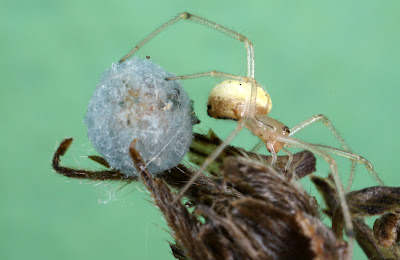Well on one recent outing, I did accomplish the latter, I'll leave you to decide whether I also did the same with the former...
These strange little critters represent a first for me, in that I have never found or photographed them before; at least, not knowingly. I did once photograph a single individual by accident-I was photoing something else, when one wandered into the shot, but they are so small that I didn't even realise until I looked at the picture on my computer.
What are they? These are member of the order-Thysanoptera, they are Thrips.
There are eggs, instars and adults in these photos.
There doesn't seem to be too much information readily available one these but I have discovered that there are apparently 6,00 species worldwide. Almost half feed on fungi and they lay their eggs in crevices under bark, which is where I found these. Although most are tiny at less than 1mm up to a max of 2mm, they can bite.
 |
| A closer look at an instar |
As people keep reminding me, autumn is now upon us and actually, even nature is now starting to agree, but some of the insect life seem to think it's still spring...
A couple of things that tell me a new season has arrived are the return of the springtails (Collembola)...
 |
| Allacma fusaca- Collembola
...and then the pesky craneflies that seem to be everywhere through September...
|
But most of all there are the........spiders!
There do seem to be some quite large specimens of this garden spider (Araneus diadematus) this year, amongst the females that is, the males are much smaller.
A small selection of other spiders that I have photographed...
I was particularly pleased to find this last one. It's a crab spider-Misumena vatia and unusually a male. They are not seen anywhere near as much as the larger females, probably just because they are so small in comparison...
Hang on! Having uploaded this picture, this looks very green, although I know these can change their colouring, I am not sure my i.d. is correct now? Oh well...somebody will tell me if it is wrong...
As some of you are not seeing the beauty in spiders, shall we have something that is at the other end of the spectrum as far as beauty is perceived by most people?
...and this one is a black-bean weevil...
I've also found a number of tortoise bugs in long grass in the past few days...
As you can see,they vary quite a lot in colour. I also came across this very dark instar...
As always, there are caterpillars to be found at this end of the year and I thought this one demonstrated the art of camouflage superbly?
It's not just the colour of this looper that impressed me but the pose it strikes, that even includes holding it's front feet at such an angle that it replicates the little bud at the top of the branch above it.
I should stop there-I have taken enough of your time and...you have a life to lead. Just before I depart though, it's becoming something of a tradition as I have said before, to include a 'what is that' photo for consideration. I have my own theory as to what this could be but would love to hear from anyone that knows for sure...
It was discovered under a fallen leaf and was minute-maybe only 1mm or so, but, what a fantastic structure? How could something so small be so perfectly formed? Anyway, any ideas?
As the horticulturalist once said..."That's shallot"
Until the next time...

































